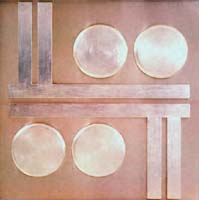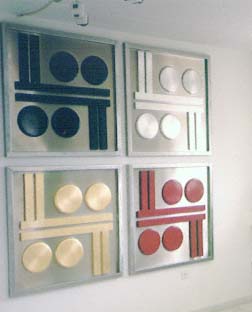

|
Markos Armaos is making his first official appearance on the Greek artistic scene with this, an exhibition of sizable sculptures, whose flawless technique, austerity of form and dynamic quality impress no end. As with all serious work, it has been a painstaking and solitary affair. More importantly, it is the culmination of years of toil: the struggle of an artist to transform his concerns and experiences into a modern vocabulary, without betraying the very essence of thought and the soul.
Born on Tinos, an island steeped in sculptural tradition, Armaos learnt the secrets of his craft long before coming to Athens to enroll in the School of Fine Arts. In any case, from his childhood days he had lived in the aura of the Cycladic spirit: a spirit of simplicity and strictness, austere but with innate vigour: abstract, long before Abstraction came into being, enriched with intrinsic knowledge belonging in time immemorial. A spirit born in the Aegean, and by inscribing a line, a gentle curve on stone, brought to light the mysterious world of Cycladic figurines. The artist's encounters with contemporary art, avant-garde movements, new trends in plastic art, polemics, freethinking and freewheelingness, in the course of his studies in Athens and, especially, Paris, did not detract him from his principles. Maybe because they went counter to his idiosyncracy, which induced him to another mode of reasoning, expressive discipline, simplicity of form and inner geometry. Even when he drew inspiration from nature's microcosm (entomology and apiculture) he inevitably turned to primeval sources. From insects with diaphanous wings and elegant, sinewy outlines, he went on to create huge-size insect eggs. That is, simple spheroid shapes of paramount importance to art and life. His years of novitiate under Thanasis Apartis indubitably enhanced his propensity for clarity.

|
However, an artist's duty is to discover a personal idiom. Armaos lived for years in solitary silence, immersed in anguished pursuits, and sharing in the acute problems confronting sculptors in this country: lack of adequate space for displaying monumental artworks, whereby sculptors are obliged to confine themselves to smaller forms; a dearth of commissioned works, especially in the public sector; and the exorbitant costs of materials. Eventually, after lengthy experiments, he managed to manipulate a strong, difficult, but highly resistant alloy - stainless steel - as a means of expressing himself.
Today he is in a happy position to present these austere masses, the resultants of compound computations and complex correlatives, but imposing in their simplicity. They are sculptures capable of being modified and incorporated into architectural entities; but first and foremost they are perfectly-executed works, with a smooth finish (as though untouched by human hands), which achieve each time surprising significance. Not ever in his career has Armaos ignored the affinity between a curve and a plane surface, and the game with empty spaces. For him, emptiness and wholeness symbolize the world's harmony: life and death. Nevertheless, in his works yet another factor contributes to the game of expression: material itself. All traces of exertion have been removed from the lustrous surface. Light invigorates it. The edges become sharper, the masses more obvious. It enhances the metallic shine while doing away with an element of coldness. It is what allows life to be reflected in the works, bestowing on Armaos' sculpture a magical touch, and allowing for endless reciprocities.
MARIA KARAVIA
|
© ART TOPOS, 1998 |
|